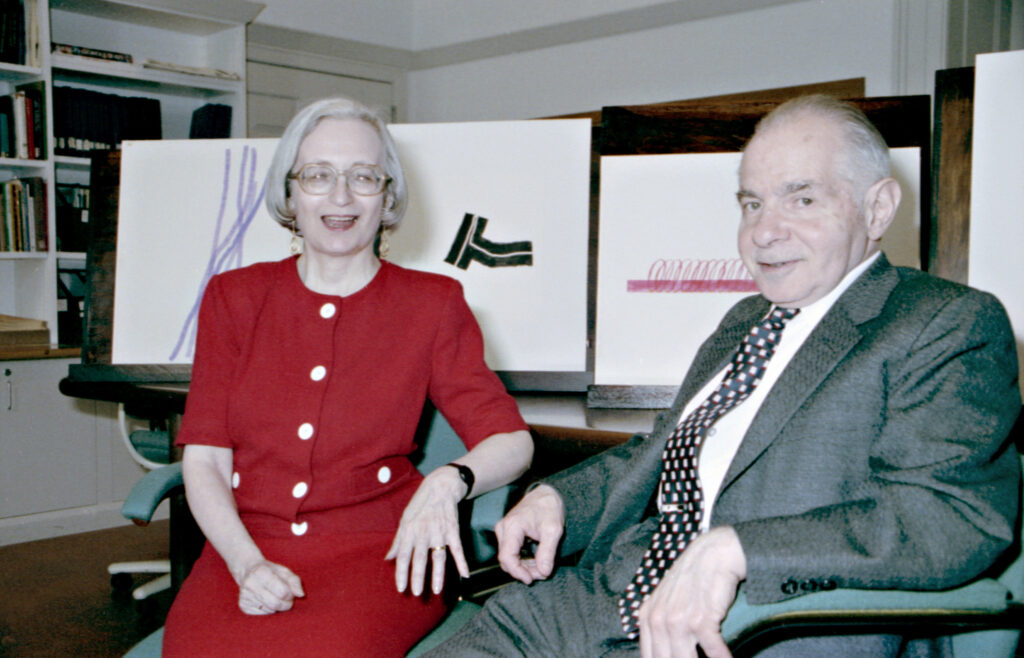Dorothy Vogel and her husband, Herbert, kept art just about everywhere. In the closet. In the bathroom. Hanging from the ceiling. “We used every space available. We couldn’t even put another toothpick in. Then the National Gallery came to the rescue,” she once said of their unlikely collection, which was built on modest means, crowded their rent-controlled New York apartment for decades and was donated en masse to the National Gallery of Art in Washington in 1992.
Mrs. Vogel died Nov. 10 at 90, more than a decade after her husband’s death at 89. Together, the couple defied art-collector stereotypes while building one of the most significant groupings of minimalist and conceptual art in the world, eventually boasting more than 4,000 works by Donald Judd, Roy Lichtenstein, Sol LeWitt, Pat Steir, Robert Mangold, Lynda Benglis, Lawrence Weiner and Edward Ruscha, among others.
“The Vogels set an extraordinary example of what it means to live with art, to care about artists, and to share beauty with the public,” Kaywin Feldman, the National Gallery’s director, said in a statement.
The story of “Herb and Dorothy,” as the couple became known, seemed the stuff of urban legend. She was a librarian, he a postal clerk. They sorted books and letters for pay and art for pleasure. Her salary they used for living, his for art-buying. While the two collected ravenously, they had their rules: Their pieces had to be affordable, portable enough that they could be transported by taxi or subway, and small enough to fit in the Vogels’ ever-more-crammed apartment on the Upper East Side.
In a way, they were the ultimate New Yorkers: gallery-going, theater-watching, art-adoring culture-lovers. The Vogels embraced the creativity teeming in the city so fully that it flooded their one-bedroom home. And while they owned a collection that could have made them millionaires, they never sold a piece before they turned their trove over to the National Gallery, allowing it to be seen by museumgoers for free.
While her husband was known for his instinctual taste and raw enthusiasm, Mrs. Vogel took a more analytical approach. A 1977 drawing by artist Will Barnet, titled “The Collectors,” showed Mrs. Vogel coolly assessing a piece while her husband, with pursed lips and a furrowed brow, leaned forward to examine it up close.
Molly Donovan, the National Gallery’s acting head of modern and contemporary art, described the couple as “truly complementary partners.”
“Herb, if you will, was kind of the Dionysian part of the pair, and Dorothy was the Apollonian,” she said in an interview. She added that Mrs. Vogel, a logician at heart, kept meticulous records of the collection and was especially attracted to minimalism because of the “strict geometry and the rules-based systems that were involved.”
“Dorothy was cautious and small in a conventional sense,” said painter Charles Clough, whose work was part of the collection. But “in the jungle that is the art world,” he added, “she was a fearless giant.”
Dorothy Faye Hoffman was born May 14, 1935, in Elmira, New York, a city she joked was great to be born in and die in, “but not in between.” Her father sold paper goods and novelties, and her mother was a homemaker.
Mrs. Vogel graduated from Syracuse University and received a master’s degree in library science from the University of Denver. By 1960, when she met her future husband, she was working for the Brooklyn Public Library. The couple married in 1962 and honeymooned in D.C., where Mrs. Vogel said she got her “first art lesson” during a trip to the National Gallery.
The two started as many collectors do, with dreams of becoming artists themselves. For a time, they lined their apartment walls with their own paintings: colorful abstract expressionists pieces by Herb, and hard-edge abstractions by Dorothy.
“There’s a quality of precision about her painting that I think is similar to the quality of precision and analysis that she brought to her thinking” about art, said her friend Anne Collins Goodyear, co-director of the Bowdoin College Museum of Art.
A month after their wedding, the Vogels bought their first piece as a married couple, a John Chamberlain sculpture made of crushed car metal. They went on to scoop up sleek minimalist works — Judd boxes, LeWitt grid drawings — and relished head-scratching conceptual art, including a piece of frayed rope (a Richard Tuttle sculpture) that they tacked to the wall with a nail and a piece of text-based art by Lawrence Weiner that Mrs. Vogel installed on her own in the bathroom.
Mrs. Vogel and her husband anticipated art-world trends, guided by what caught their eyes, how it made them feel and what they could afford. While pop art “had become expensive very quickly,” she told the Los Angeles Times in 1992, minimalism “was not accepted, and therefore it was easily available and affordable.”
They also simply “liked it, so we gravitated toward it,” she said.
The couple forged close relationships with artists and were often the first to take a risk on newcomers in the art scene. They were especially close to the installation artists Christo and Jeanne-Claude, who once gave them an artwork for looking after their cat.
Over the years, the Vogels became maximal minimalists, overdosing on an art form known for its outward simplicity, and minimal maximalists, buying as much as they could with limited resources. Asked why they liked such “austere and uncompromising art,” Mrs. Vogel said: “The more you live with it, the more you see it. It grows on you.”
In the 1970s, the couple began loaning their works to exhibitions. By the late 1980s, overwhelmed by their collection’s size, they began looking for a place to donate it. Museums came knocking, and they chose the National Gallery in part because the institution is free to the public.
In announcing the donation, the National Gallery’s director at the time, J. Carter Brown, described the Vogels’ collection as “a work of art in itself.”
“This is perhaps the premier collection of modern and contemporary drawings in a field of 20th-century art in which we were virtually barren — minimalism and conceptualism,” he said.
The Vogels were interviewed on “60 Minutes,” crowned “The Unlikely Medici” by the Los Angeles Times and, years later, featured in a pair of documentaries, “Herb & Dorothy” and “Herb & Dorothy 50×50,” by filmmaker Megumi Sasaki. The latter chronicled an effort the couple launched in 2008, in collaboration with the National Gallery, to spread some of their collection around, giving 50 works to a museum in each of the 50 states.
In an email, Sasaki recalled that while she and Mrs. Vogel grew close over the years, they clashed repeatedly while filming the first documentary. Mrs. Vogel was anxious about Sasaki shooting in “our messy apartment,” she said, but the camera kept rolling. The final cut of the film brought the art collector to tears, according to Sasaki, who recalled Mrs. Vogel saying, “The cluttered room is who we are — it’s the truth, so it’s fine,” to which Herb chimed in, “That’s the fun of it!”
After the Vogels made their gift to the National Gallery, Mrs. Vogel could remove her clothing from the terrace, where it had been stored to make room for art, and return it to the closet. It wasn’t long before art filled their apartment once again.
Mrs. Vogel’s death, at a hospital in Manhattan, was confirmed by her cousin Kathryn Obler, who did not know the exact cause. She leaves no immediate survivors.
Time and time again, coverage of the Vogels returned, with awe, to the fact that they never sold pieces to turn a profit. Their Mangold works alone were worth a small fortune, “60 Minutes” noted.
But for Mrs. Vogel and her husband, it was never about the money.
“They were genuinely motivated, I believe, by their strong commitment to the artists with whom they developed friendships,” said Goodyear, the Bowdoin museum director. “I think these artworks were not mere objects, they were expressions of people whom they cared deeply about, and whose visions they believed in.”
“People don’t go around selling their children either,” she added.
As Mrs. Vogel put it in a New York Times interview: “How do you put a price on something, or someone, that is close to you?”
The post Dorothy Vogel, unlikely art collector and National Gallery donor, dies at 90 appeared first on Washington Post.




